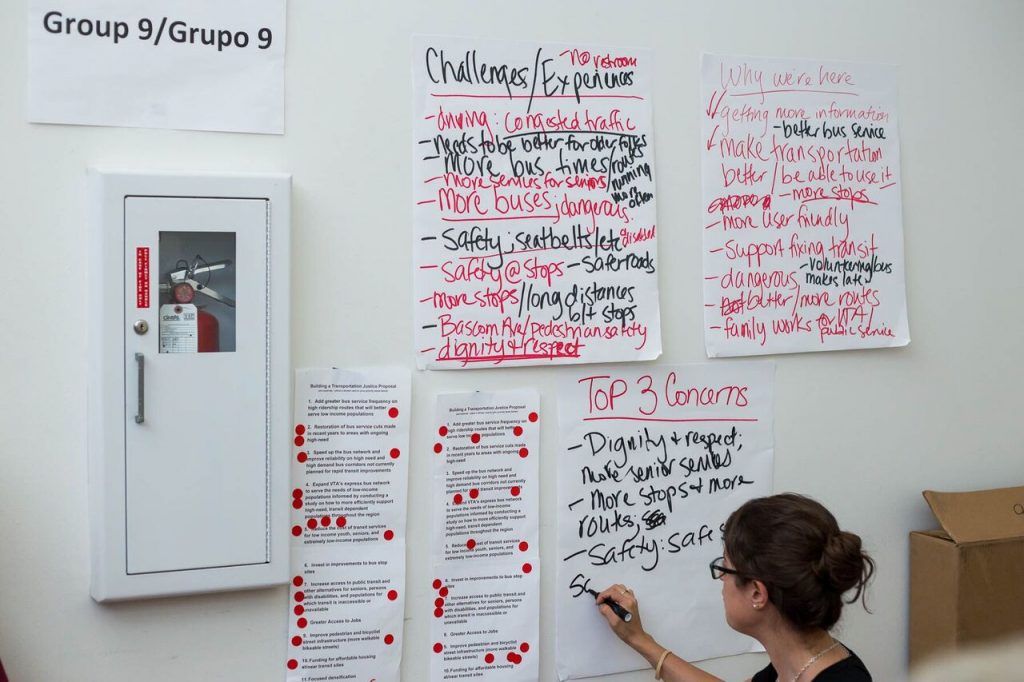
By: Mariia Zimmerman
Workers, students, care givers, and older adults are among the many different types of community members who struggle to find safe, reliable, and affordable mobility options. Increased investment over the past two decades in public transit is helping to connect more people to economic opportunity. Transit helps to reduce greenhouse gas emissions, and costs households less money to use than driving an automobile. For low-income households and communities of color, transit often provides a critical lifeline to regional jobs, schools, hospitals, parks, family, and friends.
Yet the mere presence of a bus or light rail line is not enough to fully realize transit’s full mobility potential or support other important community goals. Transit-Oriented Development, or TOD, is being embraced by numerous communities to coordinate mobility with housing, jobs, retail, schools, and other destinations through improving walkability, mixing land uses, and designing both transit and development to support each other. In short, TOD is a key tool to support strong, prosperous, and resilient communities. Not surprisingly, SPARCC regions with high quality transit systems are on the cutting edge of shaping TOD policies, plans, and projects with an emphasis on equitable, community-led development outcomes and processes.
As TOD has gained market traction, and local elected officials increasingly see it as an important tool for economic development, the conversation has evolved from convincing communities to embrace TOD to addressing its potential consequences, including acceleration of gentrification pressures and displacement of local residents and businesses faced with rising housing values and rents. Equitable TOD (eTOD) tries to correct these gaps and emphasizes transit’s role in serving mixed-income communities and prioritizes the needs of those who rely on transit. This includes broadening the definition of TOD to include issues of racial equity, community health, access to economic opportunity, and environmental goals.
Equitable TOD is a paradigm shift for both transit and development – putting community at the core, not as an afterthought. For SPARCC communities, this shift is reflected in many ways. Elevated Chicago partners are engaged in community-led corridor development work and deploying new community score cards to evaluate the social impact of proposed eTOD developments. A “New Atlanta Way” is being advocated by the Transformation Alliance which elevates community-led development and includes an effort to create a small set-aside from MARTA sales tax revenues to create a Living Transit Fund that would provide much-needed funding for affordable housing near MARTA stations. In Denver, Mile High Connects is working with the Regional Transit District to introduce an affordable transit fares program for low-income riders and also piloting a new Accessory Dwelling Unit model with the City to support wealth creation by low-income families and provide small-scale housing options in rapidly gentrifying West Denver neighborhoods. Over the years, California SPARCC partners have engaged in eTOD advocacy in many ways to push public transit agencies, regional governments, and local jurisdictions to alter the ways they engage with communities, and to prioritize affordable housing needs from new production, to preservation, to tenant protections.
Two new SPARCC eTOD publications highlight these and other strategies being advanced across the country to advance equitable development and equitable transit — both in service of and in partnership with communities. In “Lighting a SPARCC Under Equitable Transit-Oriented Development” we offer a definition of eTOD and spotlight work underway in SPARCC regions. In “Implementing Equitable Transit-Oriented Development” we break down eTOD’s many different components and illustrate each with local examples. A list of resources for additional information on eTOD implementation is provided and includes work by SPARCC team members at Enterprise Community Partners, The Federal Reserve Bank – San Francisco and the Low-Income Investment Fund, among others.
SPARCC’s eTOD materials were developed by Mariia Zimmerman of MZ Strategies, LLC. Over the past twenty years Mariia has worked on eTOD from a variety of avenues including service with Reconnecting America and the Center for Transit Oriented Development, the US Department of Housing and Urban Development, the Federal Transit Administration, on Capital Hill and in her consulting work with communities across the country on transit corridor planning, equitable development, and most recently strategies to mitigate TOD-related displacement.